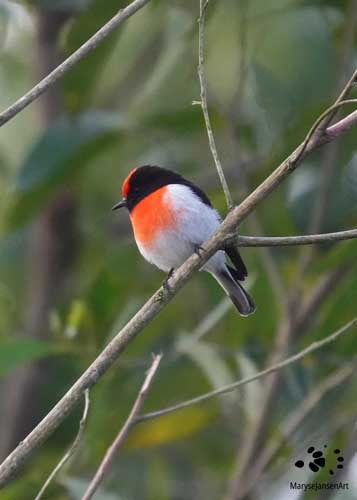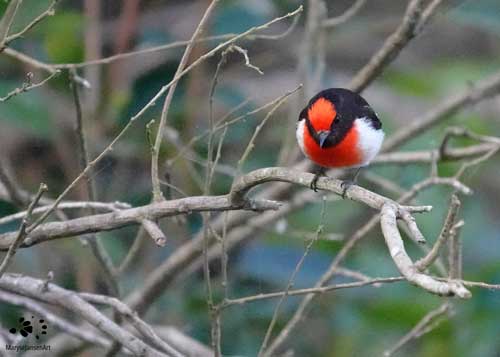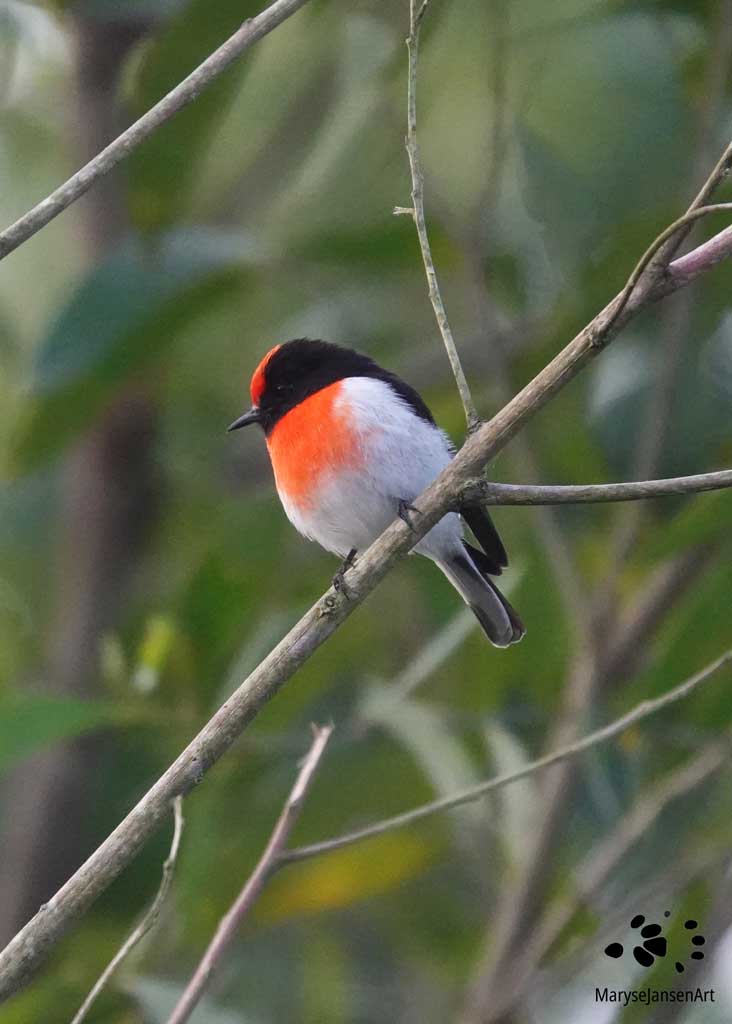Bird Photography with marysejansenart
Level of redness a sign of good health

Table of Contents
A Red-capped Robin encounter
During my walk I meet a group of birdwatchers. Really nice people, who are willing to share and they tell me about a Red-capped Robin that has been sighted nearby. Apparently it has been seen repeatedly around the same area and they take me there, in the hope to be able to show me. I follow along through the bushes. Unfortunately we’re not in luck and there is no sign of the bird. I wait for a while and then decide to continue on my walk. Too bad …
About an hour later I’ve finished up my walk and am about to drive out when I receive a message from the birdwatchers, saying: ‘We went back for another look and it’s here now!’ I turn my car in the opposite direction and drive back to where the spot was. This time, I’m in luck: the Robin is still present! So are the birdwatchers to whom I express my appreciation. What a fantastic way to end this day!
Distribution
I have never seen a Red-capped Robin before. The east coast, which is where I am now and where I spend most of my time, is not really their range. Generally, these birds stay west of the Great Dividing Range, avoid the tropical north and won’t be seen in Tasmania. They are said to only visit the east coast during droughts. Although the species occurs widespread in the drier regions of most of Australia, it is uncommon in most places, especially there where there is human activity. So despite its colourful appearance it is not so often spotted.
A colourful fella
Colourful he is, this little male! The scarlet red ‘cap’ and chest are radiating against the dark, bushy backdrop! The head, neck and nape, as well as most of the wings and tail are black while the shoulder, belly and tips of the wings are white. The red colour contrasts intensely with the deep black upper parts and white underparts! Its eyes, small bill, legs and feet are also black. Females are grey-brown rather then black, and have a reddish tint to the crown and sometimes to the breast as well.
This particular bird has such a strong red colouring that it makes him attractive not only to my camera and the human eye, but also to the females! That is because the level of redness is a sign of good health! The colour is dependent on their intake of two red keto-carotenoid pigments: canthaxanthin and adonirubin. These pigments take a lot of energy to metabolize and they are also used to enhance the immune system of the bird, so by the time there is enough left over to colour the feathers this means the bird must be in a good condition!

Diet
Red-capped Robins feed mainly on beetles, but will also take spiders, ants and a variety of other insects. They usually catch their prey on the ground, by pouncing on it. Occasionally they will take something in flight. A low branch serves as a vantage point. It is most common for the birds to hunt alone or in pairs, but they can also be seen joining flocks with other species such as Thornbills, Willy Wagtails or Rufous Whistlers.
Red-capped Robin breeding habits
Breeding season runs from August to January. Apart from the red colour, the male also advertises his presence to the female by song. Once he gets her interest, he will propose several nest sites by rubbing up against suitable forks in the tree and trilling continuously. Interestingly, once the female decides on where to build, she does the building of the nest all by herself! She makes a big effort creating a cup-nest from dried grass and bark, filling it with spider webs, fur and feathers and decorating it with lichen for camouflage.
She lays a clutch of 2-3 eggs and incubates those by herself as well. The male keeps an eye on the nest from a branch nearby while she goes out to feed herself though. Once the eggs hatch, the male and female birds both get involved in feeding the chicks. While the male and female form a long term bond in raising offspring together, extra-pair mating (mating outside this pair) is quite common. It also happens fairly regularly therefore that the young are raised by a different male then their biological father.
Like Red-browed Finches, the breeding process has a quick turn around and up to three broods can be raised each season. These birds moult once a year, after the breeding season. Juveniles look similar to the females. By the second moult, the young birds will develop their adult plumage. They can live about 5 years.
Generally, they are very active and avoid human contact, but this bird I’m looking at here doesn’t seem to mind our presence much. So although he moves around a lot, we do get the chance to get a good look at him and take our photos!
Join me on my walk in the latest episode of ‘Come for a walk in the Australian Bush’ and be sure to watch until the end to see the Red-capped Robin!
If you are interested in purchasing a print of ‘Red-capped Robin’ or would like to see what the image looks like on the various merchandise products, please head to my shop.


